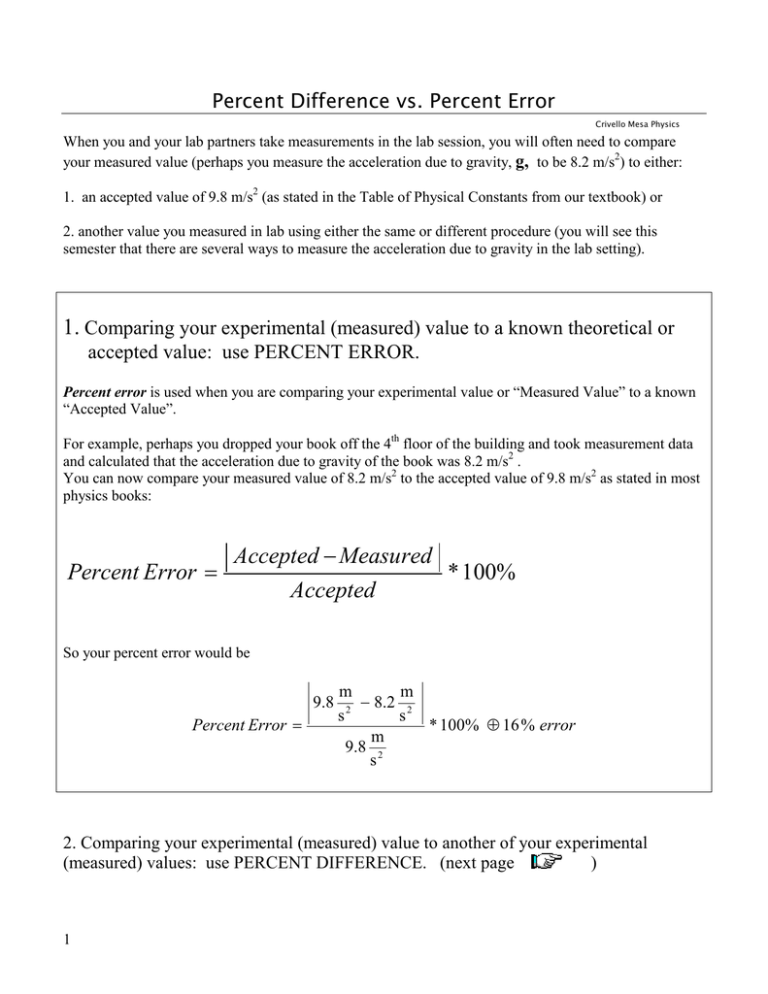Percent Difference vs. Percent Error Guide
advertisement

Percent Difference vs. Percent Error Crivello Mesa Physics When you and your lab partners take measurements in the lab session, you will often need to compare your measured value (perhaps you measure the acceleration due to gravity, g, to be 8.2 m/s2) to either: 1. an accepted value of 9.8 m/s2 (as stated in the Table of Physical Constants from our textbook) or 2. another value you measured in lab using either the same or different procedure (you will see this semester that there are several ways to measure the acceleration due to gravity in the lab setting). 1. Comparing your experimental (measured) value to a known theoretical or accepted value: use PERCENT ERROR. Percent error is used when you are comparing your experimental value or “Measured Value” to a known “Accepted Value”. For example, perhaps you dropped your book off the 4th floor of the building and took measurement data and calculated that the acceleration due to gravity of the book was 8.2 m/s2 . You can now compare your measured value of 8.2 m/s2 to the accepted value of 9.8 m/s2 as stated in most physics books: Percent Error = Accepted − Measured * 100% Accepted So your percent error would be 9.8 Percent Error = m m − 8.2 s2 s2 * 100% ≈ 16 % error m 9.8 2 s 2. Comparing your experimental (measured) value to another of your experimental (measured) values: use PERCENT DIFFERENCE. (next page ) 1 2. (a) Comparing your experimental (measured) value to another of your experimental (measured) values: use PERCENT DIFFERENCE. Percent difference is used when you are comparing your experimental value or “Measured Value” to another of your experimental values. For example, let’s say that after you dropped the book off the roof, you wrapped a string around your book and oscillated it as a simple pendulum and calculated a 2nd value of g to be 8.3 m/s2. You can now compare both of your measured values of g to each other using a Percent Difference : Your measured values are: Measured1 and Measured2 Percent Difference = Measured 1 − Measured 2 Measured 1 + Measured 2 2 * 100% So your percent difference between your two measured values would be m m − 8.3 2 2 s s m m 8.2 2 + 8.3 2 s s 2 8.2 Percent Difference = * 100% ≈ 1% difference This last calculation shows that your two experimental measurements of g are very close to each other ( within 1% ), but both values are more than 15 % lower than the accepted value of 9.8 m/s2. Here is another application of PERCENT DIFFERENCE: 2 2. (b) No known accepted value - Comparing your experimental (measured) value to another of your experimental (measured) values: use PERCENT DIFFERENCE. For example, let’s say that using a meter stick you measure the range of a projectile to be 24.5 cm. Then you measure the vertical displacement of the projectile, which allows you to calculate the range to be 25.6 cm. Since there is no accepted or theoretical value for your projectile’s range, you can only compare the two values to each other, and not to some known value found in your textbook. You can now compare both of your measured values to each other using a Percent Difference : Your measured values are: Measured1 and Measured2 Percent Difference = Measured 1 − Measured 2 Measured 1 + Measured 2 2 * 100% So your percent difference between your two measured values would be Percent Difference = 24.5 cm − 25.6 cm 24.5 cm + 25.6 cm 2 * 100% ≈ 4 % difference . Keep this with you and use it as a guide throughout our lab sessions. 3